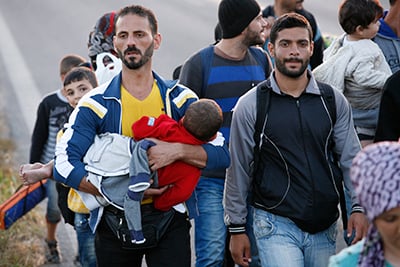Last week, a picture of a little boy on a beach shocked the world. People everywhere took notice—not because he was enjoying a vacation with his family, but because he was dead. That 3-year-old boy, Aylan Kurdi, has become the image of the refugee crisis unfolding in Europe and the Middle East.
 Aylan lay facedown in the surf on a beach in Turkey. Not far from his body lay the bodies of his 5-year-old brother and mother. They were refugees who fled their war-torn home of Syria to seek sanctuary on the Greek island of Kos. But they never made it. They were killed when their small, overloaded boat capsized.
Aylan lay facedown in the surf on a beach in Turkey. Not far from his body lay the bodies of his 5-year-old brother and mother. They were refugees who fled their war-torn home of Syria to seek sanctuary on the Greek island of Kos. But they never made it. They were killed when their small, overloaded boat capsized.
More than 360,000 people have arrived in Europe, via land and sea, this year. In July alone, countries in Europe received 107,000 refugees. More than 80% of new arrivals are refugees from Syria, with another 17% from Iraq and Afghanistan.
 Refugees make their way toward the Greek-Macedonia border. Photo by Matthieu Alexandre/Caritas Internationalis
Refugees make their way toward the Greek-Macedonia border. Photo by Matthieu Alexandre/Caritas Internationalis
While Aylan’s story is tragic, his death has brought the realities of a humanitarian crisis to the world stage. More than 59 million people were displaced in 2014. Most were from Syria, Afghanistan, Iraq, Somalia and Eritrea. Many have found refuge in countries in the Middle East, like Jordan, Lebanon and Turkey, while others are seeking refuge in Europe.
The United Nations has declared this the worst refugee crisis since World War II. CRS was there then, just like we are there now. The Catholic bishops of the United States established Catholic Relief Services during World War II. Our mission then was to bring humanitarian relief to war-torn Europe.
More than 70 years later, we continue to serve those in greatest need. We will serve more than 35,000 people in Europe in September alone. We rely on your prayers and donations to do it.
Conflicts, civil strife and economic conditions in the Middle East, Asia and Africa have dramatically increased the flow of refugees and economic migrants to Europe. With the Syrian conflict in its fifth year, a combination of desperation and hope is leading people to make difficult choices. Those choices put their financial security—and their families’ lives—at risk.
Pope’s plea for refugees
Pope Francis is asking parishes in Europe to house refugees. “The Gospel calls us, asks us to be ‘neighbors’ of the smallest and most abandoned,” he says. While taking in refugees may not be an option for many of us here in the United States, we can open our hearts.
By the time refugee families arrive in countries like Greece and Serbia, they are exhausted and hungry. Many have fled war, bombings or extreme poverty. Some have lost family members along the way, while others have had to carry children or relatives with disabilities. CRS is working with our Church partners in Greece, Albania, Macedonia and Serbia to provide immediate assistance, including food, water, sanitation, medical care and legal services. We are meeting their basic human needs, regardless of their national, religious and ideological beliefs. We are providing humanitarian relief kits at key transit points and in locations where refugees are arriving with their families. Essential living supplies include sleeping bags and mats, hygiene packages, food, clean water and other support.
CRS is also taking care of needs that are sometimes hidden. Refugees arriving in a new country rarely receive complete or accurate information about their rights to apply for asylum. And information is often not in their native language. CRS and our Church partners are providing critical information, translation and language services as well as legal resources, so refugees and migrant families know their rights and can make informed decisions.
CRS is also calling on the United States to continue and expand humanitarian assistance to Syrian refugees, especially in those countries in the Middle East and Turkey that have been sheltering the largest number of Syrians and Iraqis as well as countries burdened by this new migration.
During World War II, CRS responded to the needs of the most vulnerable. With your help, we are doing the same thing today. We hope our work, and the work of so many others around the world, becomes the image and the solution to the worldwide refugee crisis—instead of a picture of a child on a beach.
[embed]https://www.youtube.com/watch?v=g20pH7xUThA[/embed]
MORE RESOURCES:
Donate: Help Families Fleeing the Conflict-Torn Middle East
Learn More: CRS Scales up Response to European Migrant Crisis
Video: Serbia—At the Heart of Europe's Refugee Crisis
Photo Gallery: Refugee Crisis: Weary Travelers Reach Serbia
Read: Syrian Refugees Test Debit Card Aid
Read: Reaching More Than 88,000 Refugees with Lifesaving Help
Read: European Migrant Crisis Grows
Explore: Our Work in Lebanon and Jordan
Act: European Refugee Crisis: 7 Things You Can Do to Help
Respond: Walking in Solidarity with Syrians
Read: Meeting Syrian Refugees
Read: CRS Staffer Describes the Plight of Refugees in Europe
Rebekah Kates Lemke is Web producer with Catholic Relief Services, operating out of Baltimore, Maryland.
All photos courtesy of Catholic Relief Services. All rights reserved.
About the Author

Catholic Relief Services
Catholic Relief Services is the official international humanitarian agency of the Catholic community in the United States. We are the official overseas relief and development agency of the U.S. Conference of Catholic Bishops and a member of Caritas International and the National Catholic Development Conference. Find us on Facebook, Twitter, YouTube, Google Plus and Pinterest.



.png?width=1806&height=731&name=CatholicMom_hcfm_logo1_pos_871c_2728c%20(002).png)
Comments